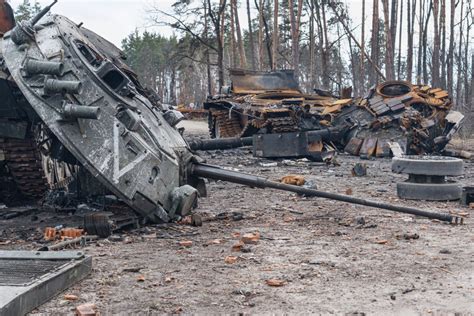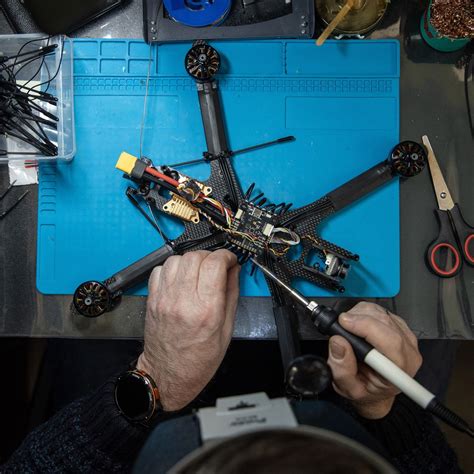
Ukraine is increasingly using drones to target high-value Russian assets behind enemy lines, shifting away from a primary focus on tanks in favor of disrupting Russia’s war effort by striking critical infrastructure and logistical hubs, according to drone unit commanders. This strategic adjustment reflects both the evolving dynamics of the conflict and the increasing effectiveness of Ukrainian drone technology.
Drone warfare in Ukraine is undergoing a transformation, moving beyond frontline tank engagements to a more strategic approach aimed at crippling Russia’s capacity to wage war. Ukrainian drone units are now prioritizing attacks on key Russian assets located deep within occupied territory, focusing on logistical nodes, command centers, and vital infrastructure that support Moscow’s military operations. This shift, driven by a combination of necessity and technological advancement, marks a significant evolution in Ukraine’s defense strategy.
“We are now focusing on more valuable targets,” stated a drone unit commander in an interview, highlighting the changing priorities on the battlefield. This refocusing is largely attributed to the increasing sophistication and range of Ukrainian drones, coupled with a growing understanding of Russian vulnerabilities. Early in the war, drones were primarily used for reconnaissance and direct attacks on armored vehicles. However, as the conflict has progressed, Ukrainian forces have adapted their tactics to maximize the impact of their drone capabilities.
One major factor influencing this shift is the high attrition rate of tanks on both sides. Direct engagements in trench warfare have proven costly, and anti-tank weaponry supplied by Western allies, while effective, can only stretch so far. By targeting logistical hubs and supply lines, Ukrainian forces aim to weaken Russia’s ability to sustain its frontline troops, indirectly reducing the need for direct tank-on-tank battles.
The strategic advantages of targeting Russian assets deep behind the front lines are manifold. Firstly, it disrupts the flow of supplies, including ammunition, fuel, and spare parts, to Russian forces. Secondly, it degrades Russia’s command and control capabilities by targeting communication centers and headquarters. Thirdly, it creates a climate of fear and uncertainty among Russian troops, impacting morale and operational effectiveness.
The evolution of drone technology has been crucial to this strategic shift. Early-generation drones had limited range and payload capacity, restricting their use to close-range engagements. However, advancements in drone design, navigation systems, and explosive technology have enabled Ukrainian forces to deploy drones capable of striking targets at much greater distances. These newer drones are also equipped with sophisticated sensors that allow them to operate effectively in all weather conditions and at night.
Furthermore, the decentralized nature of Ukrainian drone operations has contributed to their success. Rather than relying on a centralized command structure, Ukrainian drone units often operate independently, allowing for greater flexibility and adaptability. This decentralized approach makes it more difficult for Russian forces to detect and counter Ukrainian drone attacks. The use of First-Person View (FPV) drones, in particular, has become increasingly prevalent. These drones, flown using virtual reality headsets, allow operators to pilot with precision, enabling them to target specific components of enemy equipment or infrastructure.
The impact of these drone strikes on Russian logistics and morale is becoming increasingly evident. Reports from the front lines suggest that Russian forces are experiencing shortages of essential supplies, and that morale among troops is declining. This has led to a decrease in the intensity of Russian attacks in some areas, giving Ukrainian forces an opportunity to consolidate their defenses and launch counteroffensives.
However, the use of drones also presents challenges. Russian forces have adapted their defensive tactics, deploying electronic warfare systems to jam drone signals and using anti-drone weaponry to shoot down incoming drones. Ukrainian drone units must constantly innovate and adapt their tactics to overcome these challenges. This includes developing drones with greater resistance to electronic jamming, as well as using swarming tactics to overwhelm Russian defenses.
The shift towards targeting high-value Russian assets represents a strategic evolution in Ukraine’s defense strategy. By focusing on crippling Russia’s ability to wage war, rather than simply engaging in direct combat, Ukrainian forces are maximizing the impact of their limited resources. As drone technology continues to advance, it is likely that drones will play an even more important role in the conflict in the future.
The success of Ukrainian drone operations also depends heavily on intelligence gathering. Ukrainian forces rely on a variety of sources, including satellite imagery, signals intelligence, and human intelligence, to identify and locate key Russian assets. This intelligence is then used to plan and execute drone strikes with maximum precision. The effectiveness of this intelligence-gathering effort is a testament to the resilience and ingenuity of the Ukrainian people.
The international community has played a crucial role in supporting Ukraine’s drone warfare efforts. Many countries have provided financial assistance, technical expertise, and drone technology to Ukraine. This support has been essential in enabling Ukrainian forces to develop and deploy their drone capabilities. However, more support is needed to help Ukraine maintain its technological edge over Russia.
The ethical implications of drone warfare are also an important consideration. While drones offer the potential to minimize civilian casualties by allowing for more precise targeting, there is also a risk of unintended harm. Ukrainian forces are committed to adhering to international humanitarian law and taking all feasible precautions to protect civilians. However, the fog of war can make it difficult to avoid civilian casualties entirely.
Looking ahead, it is likely that drone warfare will continue to evolve and play an increasingly important role in future conflicts. The development of new drone technologies, such as autonomous drones and artificial intelligence-powered drones, will further transform the battlefield. It is essential that the international community engages in a robust discussion about the ethical and legal implications of these new technologies to ensure that they are used responsibly.
The impact of drone warfare extends beyond the battlefield. The use of drones to target Russian assets has had a significant impact on the Russian economy. Disruptions to supply lines and damage to infrastructure have hampered Russia’s ability to export goods and services, contributing to a decline in economic growth. The psychological impact of drone strikes on the Russian population is also significant. The constant threat of drone attacks creates a climate of fear and uncertainty, which can undermine public support for the war.
The Ukrainian strategy highlights a crucial aspect of modern warfare: asymmetric warfare. Ukraine, lacking the sheer military power of Russia, has leveraged technology and innovative tactics to level the playing field. The reliance on drones embodies this strategy, allowing Ukraine to strike at the heart of Russia’s war machine with relatively limited resources. This approach has not only inflicted material damage but also forced Russia to divert resources to defend against drone attacks, further straining its war effort.
Furthermore, the success of Ukrainian drone warfare has broader implications for other nations facing similar threats. It demonstrates the potential of drones to deter aggression and defend against larger, more powerful adversaries. This is particularly relevant for countries that lack the resources to maintain large standing armies or navies. The Ukrainian experience underscores the importance of investing in drone technology and developing effective counter-drone strategies.
The ongoing conflict in Ukraine provides valuable lessons about the future of warfare. It highlights the importance of technology, innovation, and adaptability. It also underscores the need for international cooperation to support countries facing aggression. The Ukrainian people have demonstrated remarkable resilience and determination in the face of adversity. Their fight for freedom and independence is an inspiration to the world.
In the context of a protracted war, the shift towards targeting high-value assets with drones reflects a long-term strategic calculation. Ukraine is not simply trying to win individual battles; it is trying to degrade Russia’s long-term capacity to wage war. By targeting logistical hubs, command centers, and infrastructure, Ukraine is aiming to weaken Russia’s economy, undermine its military capabilities, and erode public support for the war. This approach requires patience, persistence, and a willingness to accept short-term setbacks in pursuit of long-term strategic goals.
The use of drones is also a powerful tool for shaping public opinion. Ukrainian drone strikes are often filmed and shared on social media, providing the world with a firsthand glimpse of the conflict. These videos can be used to rally support for Ukraine, demonize Russia, and influence international policy. The information war is an integral part of the conflict, and drones play a key role in shaping the narrative.
The success of Ukrainian drone operations has also raised concerns about the proliferation of drone technology. As drones become more affordable and accessible, there is a growing risk that they will be used by non-state actors, such as terrorist groups and criminal organizations. This could lead to a significant increase in violence and instability around the world. It is essential that the international community works together to prevent the proliferation of drone technology and ensure that it is used responsibly.
The Ukrainian experience highlights the importance of investing in research and development of new drone technologies. As drone technology continues to evolve, it is crucial that Ukraine maintains its technological edge over Russia. This requires ongoing investment in research and development, as well as close cooperation with international partners. The future of warfare will be shaped by technology, and Ukraine must be at the forefront of innovation.
Finally, the success of Ukrainian drone warfare is a testament to the courage and skill of the Ukrainian drone operators. These individuals are often operating in extremely dangerous conditions, risking their lives to defend their country. Their dedication and sacrifice are an inspiration to us all. They are the unsung heroes of the conflict, and their contributions should not be forgotten.
The evolving drone strategy also encompasses psychological warfare. Regularly striking key assets behind Russian lines creates an atmosphere of unease and fear among Russian soldiers and local collaborators. This constant threat can significantly impact morale, leading to decreased effectiveness and potential desertions. The psychological impact is often underestimated but is a crucial component of Ukraine’s overall strategy. Furthermore, showcasing these drone strikes through social media channels serves to further amplify the psychological effect, both on the battlefield and within Russia itself.
The financial implications of destroying high-value targets are substantial for Russia. Replacing destroyed equipment and infrastructure requires significant resources, further straining the Russian economy, which is already under pressure from international sanctions. This economic pressure can, in turn, impact Russia’s ability to sustain its war effort in the long term. Targeting specific infrastructure like fuel depots or ammunition storage also creates cascading effects, disrupting supply chains and logistical operations.
Ukraine’s drone program also relies heavily on innovation and adaptation. Facing a technologically superior adversary, Ukrainian engineers and drone operators have been forced to develop creative solutions to overcome Russian defenses. This includes modifying existing drones, developing new tactics, and leveraging open-source technology. This spirit of innovation has been crucial to the success of the drone program and underscores the importance of adaptability in modern warfare.
The geographical aspects of the conflict also play a significant role in the drone strategy. Ukraine’s long border with Russia and the relatively flat terrain of the Donbas region provide ample opportunities for drone operations. However, they also present challenges, such as the need to operate in contested airspace and the risk of drones being shot down by Russian air defenses. Ukrainian drone operators have had to become adept at navigating these challenges, using terrain masking, electronic warfare techniques, and other methods to evade detection.
The collaboration between the Ukrainian military and civilian volunteers has been a defining characteristic of the drone program. Many Ukrainian civilians have contributed their skills and resources to the effort, building drones, providing technical support, and raising funds. This grassroots support has been essential to the success of the program and demonstrates the Ukrainian people’s commitment to defending their country. This symbiotic relationship highlights a unique aspect of Ukraine’s defense strategy, leveraging the ingenuity and dedication of its civilian population.
The legal framework surrounding drone warfare is complex and evolving. While international law permits the use of drones in armed conflict, it also imposes certain obligations on states, such as the obligation to distinguish between combatants and civilians and to take all feasible precautions to avoid civilian casualties. Ukraine has stated its commitment to complying with international law in its drone operations, but the application of these laws in the context of a complex and rapidly evolving conflict is often challenging.
The training of drone operators is a critical component of the Ukrainian drone program. Ukrainian drone operators undergo rigorous training to learn how to pilot drones, operate sensors, analyze intelligence, and engage targets. This training is often conducted by experienced military personnel and civilian experts, and it covers a wide range of topics, from basic flight skills to advanced tactics. The effectiveness of Ukrainian drone operations is a testament to the quality of this training.
The ethical considerations surrounding the use of lethal force by drones are complex and often debated. While drones offer the potential to minimize civilian casualties by allowing for more precise targeting, they also raise concerns about the dehumanization of warfare and the potential for unintended consequences. It is essential that these ethical considerations are carefully considered and that appropriate safeguards are put in place to ensure that drones are used responsibly.
The information security aspects of drone operations are also of paramount importance. Ukrainian drone operators must take steps to protect their drones and communication systems from cyberattacks and electronic warfare. This includes using encryption, secure communication protocols, and other security measures. The integrity of the data collected by drones is also critical, as this data is used to make decisions about targeting and other operational matters.
The coordination between different branches of the Ukrainian military is essential for the success of drone operations. Drones are often used to support ground troops, providing them with real-time intelligence and fire support. This requires close coordination between drone operators, ground commanders, and other military personnel. The effectiveness of this coordination is a key factor in Ukraine’s success on the battlefield.
The use of drones in Ukraine has also had a significant impact on the global arms market. Many countries are now investing heavily in drone technology, both for offensive and defensive purposes. This trend is likely to continue in the future, as drones become an increasingly important component of modern warfare. The Ukrainian experience provides valuable lessons for other countries about the potential of drones and the challenges of defending against them.
The psychological toll on drone operators is an often overlooked aspect of drone warfare. Operating drones remotely can be a stressful and emotionally demanding task, particularly when operators are responsible for making life-or-death decisions. Ukrainian drone operators are often exposed to graphic images and videos of the battlefield, and they may experience feelings of guilt, anxiety, and post-traumatic stress. It is essential that drone operators receive adequate psychological support to help them cope with the stresses of their job.
The impact of drone strikes on the environment is also a growing concern. Drone strikes can damage infrastructure, release pollutants into the air and water, and disrupt ecosystems. It is essential that the environmental impact of drone strikes is carefully considered and that steps are taken to minimize the harm to the environment. This includes using precision weapons to minimize collateral damage and taking steps to clean up contaminated sites after drone strikes.
The international legal framework governing the use of drones is still evolving. There is no universally agreed-upon definition of what constitutes an illegal drone strike, and there is much debate about the application of existing laws to drone warfare. It is essential that the international community works together to clarify the legal framework governing the use of drones and to ensure that drones are used responsibly and in accordance with international law.
The future of drone warfare is likely to be characterized by increasing autonomy and sophistication. As artificial intelligence technology continues to advance, it is likely that drones will become increasingly autonomous, capable of making decisions without human intervention. This raises a number of ethical and legal concerns, and it is essential that these concerns are carefully considered before autonomous drones are deployed on the battlefield.
The use of drones in Ukraine has demonstrated the potential of this technology to transform warfare. Drones offer a number of advantages over traditional weapons systems, including their relatively low cost, their ability to operate in dangerous environments, and their precision targeting capabilities. However, the use of drones also raises a number of ethical, legal, and strategic challenges. It is essential that these challenges are carefully considered and that appropriate safeguards are put in place to ensure that drones are used responsibly and in accordance with international law.
Frequently Asked Questions (FAQ):
-
Why is Ukraine shifting its drone focus from tanks to other Russian assets?
- The shift is driven by a combination of factors, including the high attrition rate of tanks, the increasing range and sophistication of Ukrainian drones, and a desire to disrupt Russia’s war effort by targeting key logistical hubs, command centers, and infrastructure. As quoted from the source, Ukrainian drone unit commanders mention focusing on “more valuable targets” to maximize impact.
-
What types of Russian assets are now being prioritized by Ukrainian drone strikes?
- Ukrainian forces are now prioritizing logistical nodes, supply lines, command centers, communication centers, fuel depots, ammunition storage, and other critical infrastructure located deep within Russian-occupied territory. The goal is to weaken Russia’s ability to sustain its frontline troops and degrade its command and control capabilities.
-
How has drone technology evolved to enable this strategic shift?
- Advancements in drone design, navigation systems, and explosive technology have enabled Ukrainian forces to deploy drones capable of striking targets at much greater distances. These newer drones are also equipped with sophisticated sensors that allow them to operate effectively in all weather conditions and at night. The use of First-Person View (FPV) drones has also become increasingly prevalent, enabling operators to pilot with precision.
-
What challenges does Ukraine face in conducting these drone strikes deep behind enemy lines?
- Russian forces have adapted their defensive tactics, deploying electronic warfare systems to jam drone signals and using anti-drone weaponry to shoot down incoming drones. Ukrainian drone units must constantly innovate and adapt their tactics to overcome these challenges, including developing drones with greater resistance to electronic jamming and using swarming tactics.
-
What is the international community’s role in supporting Ukraine’s drone warfare efforts?
- Many countries have provided financial assistance, technical expertise, and drone technology to Ukraine. This support has been essential in enabling Ukrainian forces to develop and deploy their drone capabilities. However, more support is needed to help Ukraine maintain its technological edge over Russia. The international community also plays a role in shaping the legal and ethical framework surrounding drone warfare.









